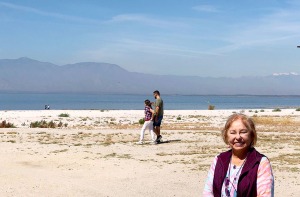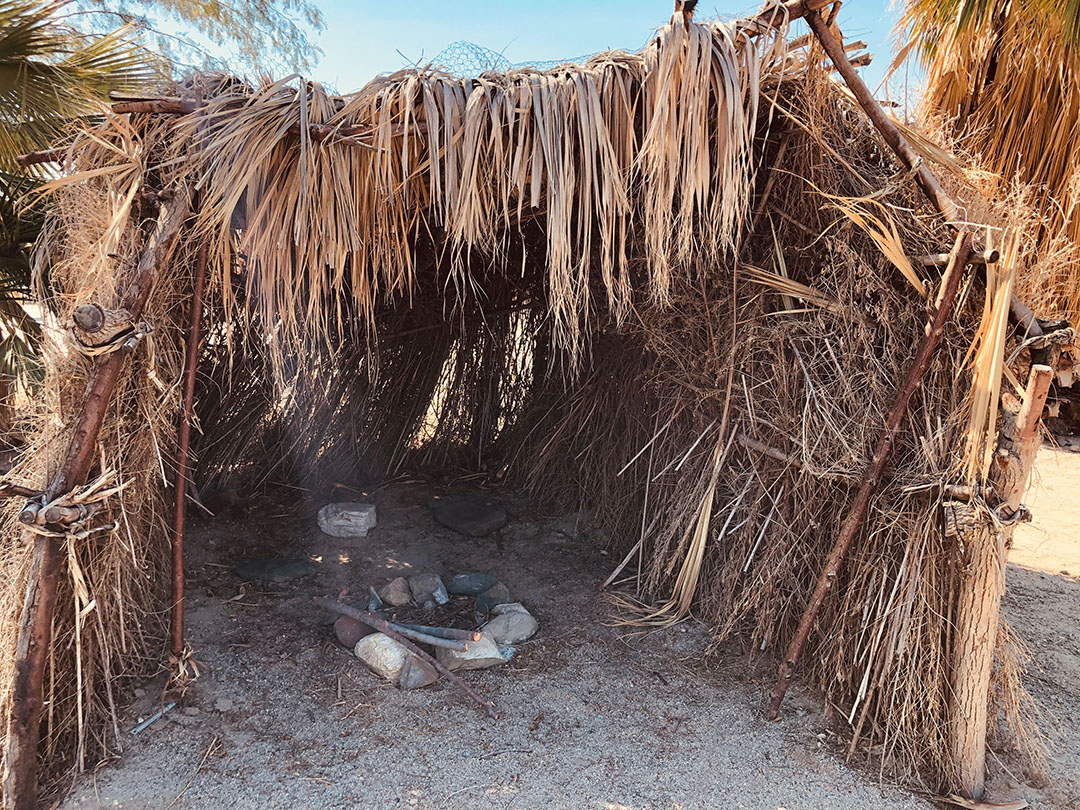The Salton Sea, Salvation Mtn. After a spring visit to Joshua Tree National Park
by Coachella Valley | January 25, 2022 2:54 am
The Road Less Traveled
FEATURED
Posted by Lois Joy Hofmann[1]
Two roads diverged in a wood, and I took the one less traveled by. And that has made all the difference. –Robert Frost

Lois at the Salton Sea Visitor Center
The Salton Sea. After a spring visit to Joshua Tree National Park, Gunter and I avoided the Anza-Borrego “super-bloom” crowds on the way back to San Diego and decided to take the road less traveled, turning toward Indio and the Salton Sea. We took CA Highway 111 to the North Shore Visitor’s Center.
The Salton Sea, 34 miles long and encompassing 343 square miles, is the largest lake in California. It is an accidental lake, born from an engineering mistake made 111 years ago. A network of irrigation canals was built across the southern part of the Salton basin. They proved too small to handle flood waters and were poorly built. Inevitably, disaster struck when heavy rainfall combined with snowmelt poured into the canals from the Colorado River. The deluge broke through the canal’s headworks, breached the levees, and flood water flowed into the massive basin.
The event created two new rivers, the New and the Alamo. Left to its own devices, the lake would have dried up due to evaporation rates of 180 cm per annum with precipitation of only 5 cm per year. But in 1928 Congress decided to use the manmade lake as a repository of runoff agricultural wastewater from the Imperial Valley, a process that continues until this day despite ongoing protests.
At the Visitor Center, we watched a short video about the ancient and modern history of the Salton Basin. Then we wandered around the area.
One sign pointed out that there are 400 different species of birds that visit this sea; some of them stay year-round. Over 400 million Tilapia live in the sea as well. Cahuilla Indians once occupied these lands.
Originally the Salton basin held a much larger body of water—ancient Lake Cahuilla, well above sea level. As the lake shrank, natives moved their villages down from the mountains and settled areas once covered by water. Fish camps followed the contours of that ancient lake.
Fast forward to the1950s, when the Salton Sea became a tourist haven. Fishing, boating, hotels, and even a yacht club caused beachfront properties to skyrocket. Business boomed as visitors came from all over California.

Cahuilla Indian dwelling
Bombay Beach. A friendly clerk at the Visitor Center said told us that Bombay Beach might be a good place to stop for a homestyle lunch. So, we drove further along 111, marveling at the desert flowers along the way.
A small sign pointed to the settlement. We drove past a ramshackle bar/restaurant sporting a sign, Home Cooking. “This can’t be right,” I stammered as we ventured inside.
I had imagined sitting on a patio under multi-colored umbrellas viewing the sea! The smell of rancid frying oil, beer, sweat and smoke assailed our senses. Gunter groped for my hand in the darkness. “Let’s get “outta here.”
Back outside and blinded by the sun, I looked back and quipped: “A collection of lost souls thrown into the dungeon.”
We pushed our Nissan onward through the sandy street, past run-down trailers, slab shacks with metal roofs, and rusty vehicles-without-tires collapsed into unkempt yards.
As we turned the corner at a concrete dike that blocked the sea view, we encountered a block filled with child-size teepees. An “artist statement” says Ghost Town. Gunter laughed. “This place is a stitch!” We left hungry; that home cooking was nowhere to be seen.
Later we learned that Bombay Beach is a “census-designated place” in Imperial County, with a population of 295 per the 2010 census, down from 366 in 2000. Its elevation is -223 feet.
A website called California Curiosities[5] concludes: “I’ve seen the world after the apocalypse, and that world is Bombay Beach.”
Surprisingly, this disaster zone was a thriving resort town during the swinging 50s and 60s. An old sign, still standing, says, WORLD FAMOUS. LOWEST BAR IN THE WESTERN HEMISPHERE.

A typical Bombay Beach scene.
Salvation Mountain. Hot, tired, and hungry, we drove further along Hwy 111 to Niland, where that same Visitor Center clerk said we couldn’t miss Salvation Mountain, right alongside the road at Niland. But we blinked, and suddenly Niland was in the rearview mirror. “Let’s go back,” I begged.
“No way!” Gunter was determined to head on to Brawley to find someplace for lunch. Then he recanted, “Well, if you drive.”
I spun around in the middle of the road (believe me, this is the road less traveled) and drove back. No mountain. I stopped at a gas station along 111. The clerk smirked as if he’d done this a thousand times. “Just continue two blocks and turn right onto Main Street. Go through town and take the road for about 2 miles. Don’t you worry when it turns into a dirt road. Can’t miss it!”
We bumped along through a deserted desert landscape until we began to see signs of life—lots of trailers and hippie-style shacks alongside the road.
Then around a turn, there it was, a psychedelic creation bigger than life! The humongous artwork is made of adobe, straw, and half a million gallons of lead-free paint.
Some areas are covered with murals, others with Bible verses and sayings. We parked alongside the road and rambled among all kinds of vans, trucks, and even a boat—all painted with Bible verses and art.
Finally, we came to the mountain itself, painted with a red heart and GOD IS LOVE in the center and topped with a white cross. We saw groups of young people trudging to the top while others sang in groups at the bottom.
What glorious diversity—people of all sizes, shapes, and colors were walking toward that mountain. Surely, the founder fulfilled his purpose!

Painted vehicles like this stand in the foreground
The Bible says that faith can move mountains. Did you know that faith can also create them? Leonard Knight wanted a mountain in his childhood dream to come true. He also wanted to move to California one day.
Born in 1931 near Burlington, Vermont, he was something of a loner and said his schoolmates made fun of him for having a stutter. So, he dropped out of tenth grade and had to learn how to survive on his own.
The New Englander spent most his years doing odd jobs in the Midwest. Then during a visit to his sister in San Diego in 1985 he arrived at this hardscrabble spot during a day trip. (Legend has it that he arrived in a hot air balloon.) After “landing,” he heard a message and began erecting a cross. Mixing water and hay, he applied a façade over a sandy ridge and then painted it with motifs and verses such as: Jesus is The Way. God Never Fails. God Forgives Sinners.
He added flowers, suns, bluebirds, waterfalls, and a river that flows from the mountain to the Lake of Galilee in the foreground. He lived in a house on the back of the Salvation Truck, a vehicle decorated with the word REPENT writ large.
For 28 years, he continued working on the project under the hot desert sun. He greeted visitors strumming his guitar and requested that all donations be in the form of lead-paint, preferably acrylic.

All paint is donated by visitors

The Salvation Truck King
“What started as a small monument of dirt and painted cement became, over time, a sprawling adobe and hay bale mountain complex, with peripheral structures made of telephone poles, tires, and car windows, as well as art cars and sculptures, all painted in a patchwork of stripes and color blocks of whatever paint was donated that week.”
—Aaron Huey, National Geographic
Salvation Mountain has grown to 50 feet high and 250 feet wide. It is truly unique and has touched and inspired visitors from all over the world. In 2011, Knight was moved into a care facility. He passed in 2014. A public charity, Salvation Mountain, Inc., was established in 2012 to support the project. coachellavalley.com[6]

Leonard Knight, builder of Salvation Mountain
For more information on Salvation Mountain, go to their website at: http://www.salvationmountain.us
Roadside America Video: https://www.roadsideamerica.com/video/61915[7]
About the Author: Lois and Günter Hofmann lived their dream by having a 43-foot ocean-going catamaran built for them in the south of France[8] and sailing around the world. Learn more about their travel adventures by reading Lois’s nautical adventure trilogy[9]. Read more about Lois and her adventures at her website https://loisjoyhofmann.[10]com
- Lois Joy Hofmann: https://sailorstales.wordpress.com/author/sailorstales/
- $300M Coachella Valley Arena Now Acrisure: https://coachellavalley.com/300m-coachella-valley-arena-now-acrisure/
- Borrego Springs and the Galleta Meadows is a Perfect Day Trip from the Coachella Valley: https://coachellavalley.com/borrego-springs-and-the-galleta-meadows/
- Borrego Springs The New Boomtown: https://coachellavalley.com/borrego-springs-the-new-boomtown/
- California Curiosities: http://www.californiacuriosities.com/
- coachellavalley.com: https://coachellavalley.com/salvation-mountain/
- https://www.roadsideamerica.com/video/61915: https://www.roadsideamerica.com/video/61915
- 43-foot ocean-going catamaran built for them in the south of France: http://loisjoyhofmann.com/sailing/
- nautical adventure trilogy: http://loisjoyhofmann.com/sailing-the-world-travel-trilogy-special/
- https://loisjoyhofmann.: https://loisjoyhofmann.com/
Source URL: https://coachellavalley.com/the-salton-sea-after-a-spring-visit-to-joshua-tree-national-park/